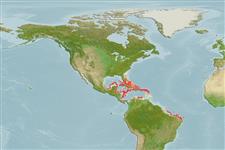>
Acropomatiformes (Oceanic basses) >
Symphysanodontidae (Slopefishes)
Etymology: Symphysanodon: Greek, syn, symphysis = grown together + Greek, physis = growth body form + Greek, odous = teeth; related to few teeth which are located over the area where the two jaws meet (Ref. 45335).
Environment: milieu / climate zone / depth range / distribution range
Ecologie
marien bathydemersaal; diepte 155 - 640 m (Ref. 54833). Deep-water
Western Central Atlantic: off the Bahamas, Cuba, Puerto Rico, Nicaragua, and Panama.
Grootte / Gewicht / Leeftijd
Maturity: Lm ? range ? - ? cm
Max length : 13.0 cm SL mannelijk / geslacht onbekend; (Ref. 51223)
Levenscyclus en paargedrag
Maturiteit | Voortplanting | Paaien | Eieren | Fecunditeit | Larven
Anderson, W.D. Jr., 2003. Symphysanodontidae. Bunquelovelies (wampeejawed fishes, shelf beauties, slopefishes). p. 1304-1307. In K.E. Carpenter (ed.) FAO species identification guide for fishery purposes. The living marine resources of the Western Central Atlantic. Vol. 2: Bony fishes part 1 (Acipenseridae to Grammatidae). (Ref. 51223)
Status op de Rode Lijst van het IUCN (Ref. 130435: Version 2024-1)
Gevaar voor de mens
Harmless
Gebruik door de mens
Tools
Speciale rapporten
Download XML
Internetbronnen
Estimates based on models
Preferred temperature (Ref.
123201): 10.8 - 19.6, mean 14.9 °C (based on 58 cells).
Fylogenetische diversiteitsindex (Ref.
82804): PD
50 = 0.5004 [Uniqueness, from 0.5 = low to 2.0 = high].
Bayesian length-weight: a=0.01000 (0.00244 - 0.04107), b=3.04 (2.81 - 3.27), in cm total length, based on all LWR estimates for this body shape (Ref.
93245).
Trofisch niveau (Ref.
69278): 3.4 ±0.4 se; based on size and trophs of closest relatives
Fishing Vulnerability (Ref.
59153): Low vulnerability (10 of 100).
